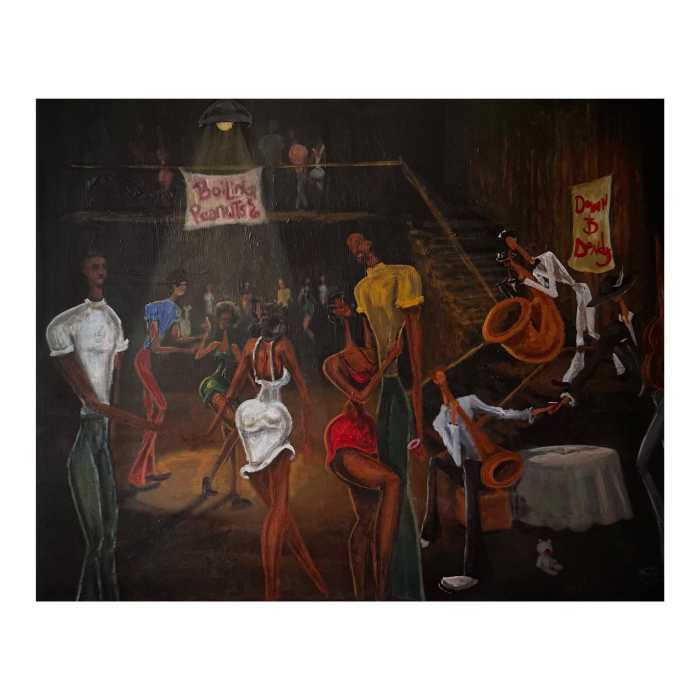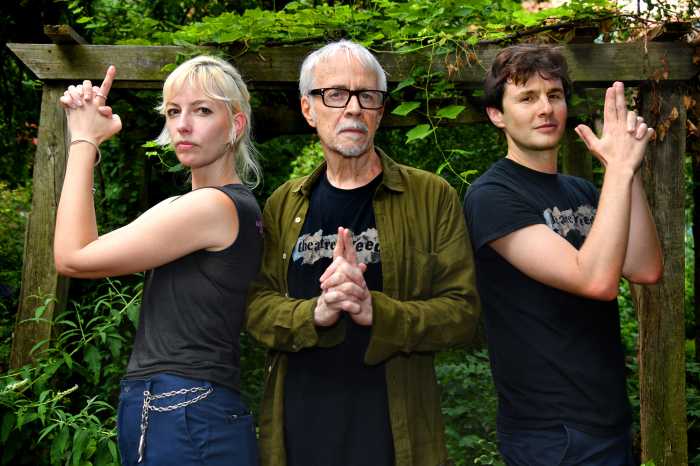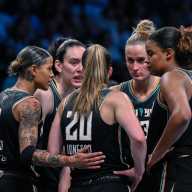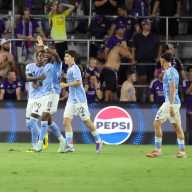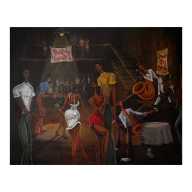By Harry Bartle
Cooper Union students had the chance to display their very own formula-style race car that they designed and built completely by themselves at the World Science Festival held in Washington Square Park on Sunday. As many of the festival’s younger visitors took turns getting their pictures taken inside the car, the four Cooper Union Formula SAE Project representatives took turns explaining why the vehicle was far more than just a good photo-op for local parents.
The car — red and gold, with the logos of the team’s sponsors scattered across its sides — looks like a scaled-down version of a professional race car. It certainly sounds professional: Not only can it reach speeds up to 100 miles per hour and accelerate from zero to 60 in less than three seconds, it’s also been equipped with such advanced racing technology as a Wi-Fi system that allows the team to check and tune certain elements on the go.
The vehicle represents the third generation of a budding tradition at Cooper where every September a team of driven engineering students gathers to design and build a car entirely from scratch that, eventually, is entered into the Michigan International Speedway competition in June. Led by Professor George Delagrammatikas, Cooper scored in the top third of the 120 competing teams this year and was formally recognized at the speedway’s culminating award ceremony as one of the only teams to have scored in each of the competition’s events.
The road to Michigan, however, was not easy.
Each of the team’s 16 students was responsible for designing a specific subsystem of the vehicle, manufacturing the necessary parts, and integrating it into the car as a whole.
“Every student had to wear a different hat,” said Delagrammatikas, “Technical, executive, outreach, marketing. There were a lot of different tasks to address with a limited number of people.”
Indeed, some of the students had to wear several hats at once. Senior Dennis Robertson, the project’s technical director and captain, was not only responsible for designing and analyzing the vehicle’s frame, but also led the suspension and brake units. Many of the team’s members, especially the seven or so that made up the project’s “core,” spent anywhere from 60 to 80 hours a week over nine months working on the project, all the while balancing their schoolwork at Cooper, one of the more rigorous undergraduate institutions in the country.
“Everybody was intense,” said Delagrammatikas. “The ones that had the bug, you had to practically fight to get them out of the lab at a decent hour.”
Before the car’s first screw was even put in place, the team spent the first semester scouring over blueprints, crafting scaled models and conducting computer-simulated analyses. After teaching themselves to use programs like Fluent or COSMOSWorks, the students tested the vehicle’s computational fluid dynamics, carried out finite-element analysis and checked hundreds of other quantities and measurements.
In January, the team began manufacturing and assembling the vehicle’s parts. The Cooper facilities, however, while certainly advanced, were not entirely equipped for heavy automotive manufacturing. So, the team had to construct its own testing stands and structures in addition to the welding, drilling and huge amount of electronic work that was necessary for such an ambitious project.
Fortunately, team members like senior James Cole-Henry, the team’s licensed welder and go-to material expert in the machine shop, had already worked on the three previous generations of Cooper’s formula SAE vehicles — allowing for quicker building times this year and the chance to improve systems, such as the crash structure.
“Every year before us helped for this year,” said Robertson, a three-year veteran of the program himself. “We saw the car as sort of an evolution of cars from past years. There were some things that went well last year that we decided not to play with, but others we knew that we had to fix.” That extra experience of some of the core members helped catapult the team 30 places higher than their previous best at the Michigan competition this year.
The team also received a boost from a variety of extremely generous sponsorships, ranging from Cooper’s own Mechanical Engineering Department to companies like Con Edison and Scotia Technology, a prime-tubing supply firm. In addition to a donation of $10,000, Con Ed supplied the Cooper team with state-of-the-art engineering parts that, according to Robertson, far surpassed their monetary contribution.
“They were very good about getting us what we needed, and they made a lot of components that we wouldn’t have been able to make,” Robertson said. He added, jokingly, “Of course, the needs of the city outweighed our needs.
I’ve heard electricity is pretty important… . But without them we really wouldn’t have been able to get where we did.”
Despite their prestigious sponsorships and years of experience, however, the Cooper team entered the Michigan competition as relative underdogs. As one of the smallest institutions in the contest, not to mention the only full-tuition, paid-scholarship school, they had considerably less resources than some of larger universities and international schools. Michigan State, one of the top competitors and located in the center of the automotive world, had a budget of $500,000, nearly 10 times Cooper’s. A team from Finland, whose Web site prominently features their 10 engineers in matching uniforms flanked by two bodacious blondes clad in skintight red patent leather, had their own indoor practice racetrack. Cooper had to trek out to College Point in Queens to test their out their car in The New York Times facility’s parking lot. Getting the 8-foot, 479-pound car out there was an ordeal in itself.
The intensity at the Michigan competition was incredibly high, but Cooper’s own grueling schedule over the previous nine months helped prepare them for it.
“People think it’s strictly a race,” said Delagrammatikas. “It’s more like an engineering challenge.” The five all-nighters during the competition, while not easy, were manageable.
“We were used to it by then,” Robertson said. “This group was sort of the cream of the crop. There was no way we were going to give up once we were there.”
Going up against some of the world’s top engineering schools, the team underwent a series of heavy examinations conducted by industry experts in which they had to present the vehicle’s technical aspects, justify all their design choices, create a hypothetical business pitch for the car and, finally, actually race it on the track. After each event, the team would take the car back to the lab and continue to do the necessary body work to prepare for the day ahead.
As might be expected, the team ran into a few problems at the competition. During the skid-pad suspension test, for example, the team ran out of fuel and was just barely able to pass the event. The endurance race almost turned into a catastrophe: At 22 kilometers of high-speed racing, the event — called “endurance” for the amount of stress it puts on the driver as well as on the vehicle — was tough to begin with; but about halfway through, a judge noticed that a small safety was missing from one of Cooper’s tires. Without the pin, the judge said, the team would not be allowed to finish. Thankfully, the team found a small loophole. Although they were not allowed to modify the car, they were allowed to switch from “dry tires” to “wet tires” because of the damp track from rain earlier in the day. The two members of the team allowed to work on the car raced furiously against the clock to install the second set of tires as quickly as possible. Ultimately, the missing pin didn’t wasn’t too costly; Cooper was one of the only teams able to finish the endurance event.
In the three years Cooper has entered the Michigan competition, the team has gone from 89th place all the way down to 37th. Despite the huge improvement rate, the team’s future looks slightly cloudy at this point. Many of the team’s leaders, including Robertson, Cole-Henry and electronics director Adam Vaughan, are all either graduating seniors or master’s students at Cooper, and next year’s team will be comprised of new and fewer faces. The plan as of now is to modify the current car enough — some subsystems will have to be totally revamped — that it will still be able to be resubmitted into the competition.
As for long-term plans, many of the team’s members aspire to go professional with their automotive engineering skills.
“Ultimately, I’d like to be in the automotive industry,” said Robertson. “But I don’t want to leave New York.”
Delagrammatikas seemed convinced his students are ready for the next step.
“Every engineering student should have this kind of hands-on experience,” the professor said. “You can’t rely on a textbook for this kind of learning. These guys are changing the way the curriculum is handled, even for others not involved… . The past nine months has trained them in every aspect of small-company management.”
The recent car industry collapse has led to the cancellation of one tournament sponsored by the Big Three that the team was planning to attend in Virginia this year. Yet, in an industry shrouded in darkness, it seems there’s a bright beacon of hope shining from Cooper Square.



